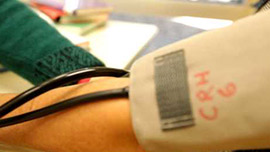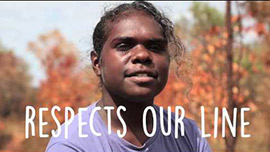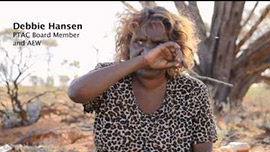Strong, safe and functioning communities can support people and provide them with a sense of connection and belonging. Connectedness to country, resilience, leadership, having a role in family and society and feeling safe are all important aspects of functioning communities for Aboriginal and Torres Strait Islander people (AHMAC, 2015).
Safe and functional housing with utilities such as electricity and running water, and infrastructure like community facilities, roads and transport also support safe communities.
What we know
Compared with other Australians, Aboriginal and Torres Strait Islander people experience disproportionately high levels of violence, substance misuse and incarceration.
Aboriginal and Torres Strait Islander men and women are more likely to be hospitalised for family-related assault than non-Indigenous Australians, 28 times more likely for men and 34 times more likely for women. Rates of hospitalisation for assault are highest in remote and very remote areas. Indigenous children are much more likely to experience child abuse and neglect (SCRGSP, 2014). Aboriginal and Torres Strait Islander people also experience high rates of suicide, self-harm and poor mental health. These problems are complex and intergenerational, and include socio-economic factors such as poor education and low employment, as well as trauma, grief and loss resulting from past government policies and practices.
These factors contribute to Aboriginal and Torres Strait Islander people being over-represented in the criminal justice system – in 2015 there were 9,885 prisoners who identified as Indigenous, representing 27 per cent of total prisoners (ABS, 2015a). Between 2000 and 2015, the imprisonment rate for Indigenous adults increased by 77.4 per cent. Rates of re-offending are high and around half of Indigenous Australians in prison are there for violent offences.
Primary responsibility for criminal justice rests with the state and territory governments, which deliver a range of programmes to reduce incarceration and re-offending. The Australian Government is working with state and territory governments to ensure its investment complements their efforts and leads to real improvements in Aboriginal and Torres Strait Islander people’s lives.
- The Government is addressing immediate issues such as violence and substance misuse at the same time working with Aboriginal and Torres Strait Islander people to build strong, resilient communities.
- Policies and services focus on keeping women and children safe, crime prevention, reducing incarceration rates, access to nutritious food and safe housing.
- Under the National Ice Action Strategy specialist drug and alcohol treatment services including Indigenous specific treatment services and culturally appropriate mainstream services will be provided.
Accelerating progress
Creating safe, healthy communities requires a multi-faceted approach. The real and immediate issues of violence and substance misuse are priorities. At the same time, it is important to create opportunities for education and employment, and support the strength, leadership and resilience of Aboriginal and Torres Strait Islander people.
The Australian Government has committed to continuing its long-term investment in the Northern Territory through a new National Partnership Agreement on Northern Territory Remote Aboriginal Investment. This new agreement, which is being negotiated with the Northern Territory Government, is an investment of more than $988 million over seven years.
All governments are working together on the priority areas of alcohol misuse, improving policing and reducing Indigenous Australians’ contact with the criminal justice system.
The Australian Government is working with 360 organisations across the country to improve community safety as part of the Indigenous Advancement Strategy: Safety and Wellbeing Programme. This includes:
- reducing substance misuse and harm through the delivery of alcohol and other drug treatment services
- crime prevention, diversion and rehabilitation through the delivery of prisoner rehabilitation and other justice-related activities
- violence reduction and victim support through the provision of legal services and family safety activities, particularly for women and children
- improved wellbeing and resilience activities to foster social participation or reduce antisocial behaviour through social and emotional wellbeing counselling activities
- creating safe and functional environments through community night patrols.
case study On patrol with Verna Peters in the APY Lands
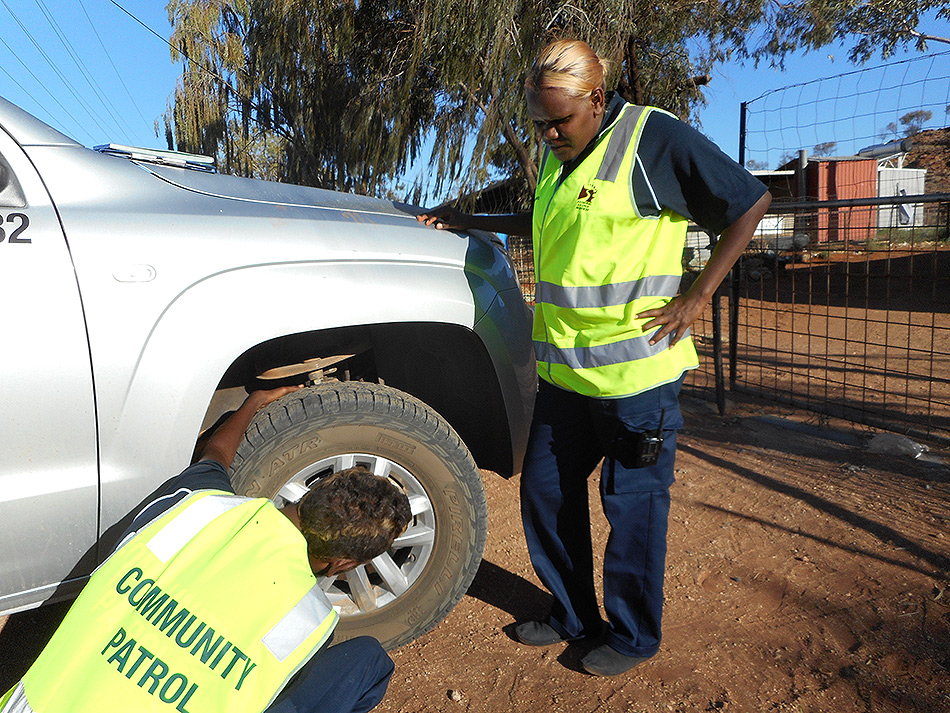
Verna Peters and her collegue Albie (Mingkili) Wilson check their vehicle before the start of a night patrol shift.
Verna Peters is a well-known and trusted member of the Pipalyatjara community on the Anangu Pitjantjatjara Yankunytjatjara (APY) Lands in the north west of South Australia.
Verna’s described as a person ‘who looks after everyone’. So it’s no surprise that on 2 November 2015, she was the first woman to become a senior Community Night Patroller for the first night patrol operation in the APY Lands. Patrols in five other communities – Amata, Ernabella, Fregon, Indulkana and Mimili have followed and in Amata, Indulkana and Pukatja women patrollers and team leaders are also helping make their communities safe.
Verna’s day job is as an Aboriginal education worker at the local preschool. When the sun goes down, she can be found working with other local Anangu people to make her community safer. This can include calming potentially violent situations, offering culturally sensitive assistance and providing transportation for either victims or perpetrators to a safe place.
Patrols have a role to play ensuring that children are at home or in another safe location at night with a parent or carer, so that they are able to go to school every day. As well as making communities safer Community Night Patrols create jobs. In 2014-15, 96 per cent of the 339 patrollers and team leaders delivering services on the ground identified as Aboriginal. In 2015-16, $28.6 million is available for Community Night Patrols across the Northern Territory, South Australia and Western Australia.
Reducing substance misuse and harm
The Government is addressing substance misuse to ensure communities are safe and healthy, and break the cycle of disadvantage. This includes restricting access to harmful substances, minimising harm, and providing rehabilitation and treatment services:
- Indigenous alcohol and other drug treatment services – support services such as residential rehabilitation, counselling, referral, transitional aftercare and sobering up shelters across Australia.
- National Ice Action Strategy – almost $300 million over four years including $241 million for specialist drug and alcohol treatment services administered through 31 Primary Health Networks including Indigenous-specific treatment services and culturally appropriate mainstream services. The Government will also work with sporting clubs in Indigenous communities, including 20 remote communities, to spread prevention messages. The National Drug Strategy Household Survey results show Aboriginal and Torres Strait Islander people are 1.6 times more likely to use methamphetamine than non-Indigenous Australians (AIHW, 2014).
- Low aromatic fuel – to reduce petrol sniffing in areas where it is a problem. In 2015, low aromatic fuel was extended to the Katherine region in the Northern Territory and the western side of Cape York in Queensland, bringing the number of sites in remote and regional Australia with low aromatic fuel to over 150. Research shows that sniffing levels have been reduced by 89 per cent in areas that have a comprehensive rollout compared with 2005-07 baseline levels (AHMAC, 2015).
Crime prevention, diversion and rehabilitation
The best way to reduce the number of Indigenous people in incarceration is by reducing offending. Preventing young Indigenous people going to prison in the first place and creating opportunities for people to move into employment when they exit the criminal justice system, is critical to reduce reoffending. This is achieved by providing education and employment opportunities and tackling alcohol and other substance misuse.
Programmes to address the factors which contribute to high rates of Indigenous incarceration include services to reduce recidivism, rehabilitation, intensive case management and community-based mediation services in remote communities. In 2014‑15 the Australian Government funded nine prisoner throughcare services that provided intensive, individualised case management for more than 1,100 prisoners, including over 750 released from prison. Of these, 179 released prisoners went on to reoffend and return to prison in 2014-15.
Protecting Women and Children
Keeping women and children safe is a priority for all governments. Australian Government strategies include:
- Women’s Safety Package – to improve frontline support and services, leverage innovative technologies to keep women safe, and provide education resources to help change community attitudes to violence and abuse. The $100 million package includes $21 million specifically targeted to Indigenous families for policing and support services.
- National Framework for Protecting Australia’s Children 2009-2020 – reflects the long-term commitment of the Australian, state and territory governments and the non-government sector to ensure the safety and wellbeing of Australia’s children. One of its priorities is to reduce the over-representation of Aboriginal and Torres Strait Islander children and young people needing child protection services.
- National Plan to Reduce Violence against Women and their Children 2010-2022 – focuses on the two main types of violent crimes that have a major impact on women in Australia–domestic and family violence and sexual assault. It acknowledges some Indigenous communities need extra assistance to address particular factors and disadvantage which contribute to the higher rates of family violence among Indigenous Australians.
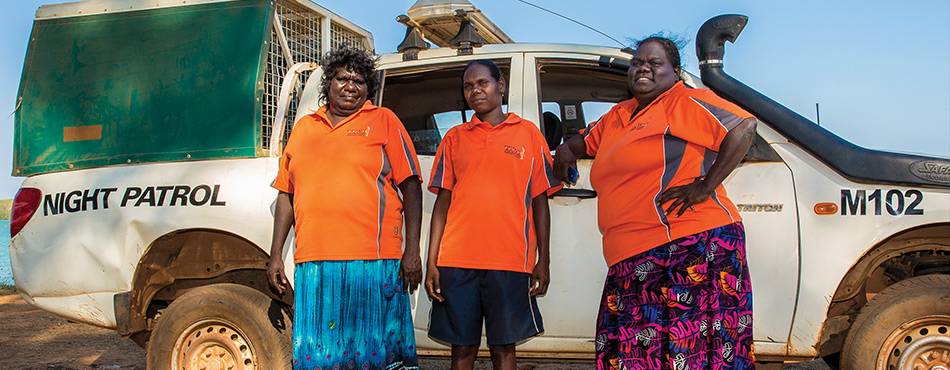
The Community Safety Patrol is delivered by the Tiwi Islands Regional Council in three communities across the Tiwi Islands. Team Leader, Jane Puatjimi, Illucia Kantilla and Rhonda Kerinaiua are members of the Wurrumiyanga Community Safety Patrol on Bathurst Island.
Community policing
State and territory governments face unique challenges in delivering effective police services to remote Indigenous communities. The Australian Government has made significant funding contributions to building new police stations and supporting infrastructure in remote communities. Two new police stations in Arlparra and Yuendumu in the Northern Territory were built last year, with another station to be built in Wadeye.
case study Policing in remote communities
The Australian and Northern Territory Governments are jointly funding Community Engagement Police Officers (CEPOs). CEPOs are experienced police officers who work across the community to support crime prevention, help out in the community and build trust with the police. They work with Remote School Attendance Officers to get children to school, and deliver road safety and ‘say no to drugs’ messages in classrooms. They also get involved in activities like organising community clean ups, sports carnivals and helping with community emergencies like cyclones.
Healthy food
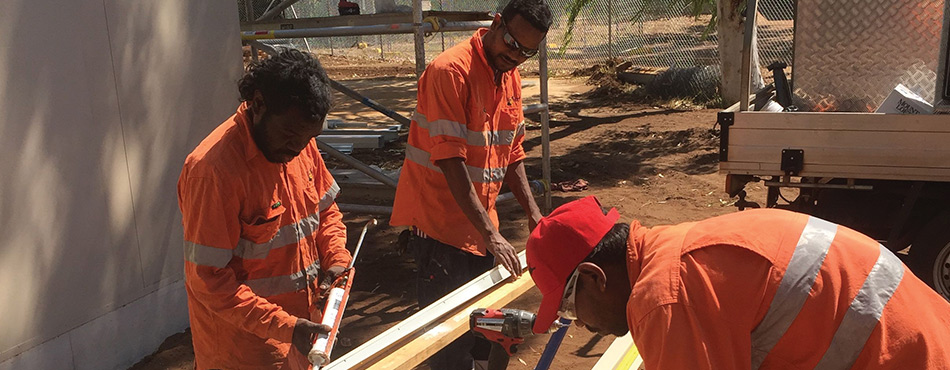
Jilkminggan community members (left to right) Stuart Yunupingu, Harry Albert and Matthew Conway at work building the community’s new store.
Nutritious food is essential for good health. In remote communities, Australian Government programmes focusing on healthy food include:
- Community Stores Licensing Scheme – supports good health and nutrition for children and families with access to high quality, affordable and safe food, drinks and grocery items in remote communities in the Northern Territory. Stores are encouraged to adopt pricing policies to make nutritious food more accessible and affordable by reducing price mark-ups on healthy food.
- Outback Stores – manages 36 stores nationally: 22 in the Northern Territory, 10 in Western Australia, three in South Australia and one in Queensland. There is a nutrition strategy in the stores to encourage and promote healthy food choices, including health promotion activities and cooking demonstrations.
- Over the past 12 months, through the Aboriginal Benefits Account, new stores have opened in Beswick, Bulman, Canteen Creek, Engawala, Epenarra and Peppimenarti and major upgrades completed in Jilkminggan and Pirlangimpi.
Cashless Debit Card Trial
The Australian Government is working closely with Indigenous and non-Indigenous community leaders in Ceduna in South Australia and in Kununurra and Wyndham in Western Australia to design the trial of a cashless debit card. These communities have expressed an interest in participating, as a way to support people, families and communities where high levels of welfare dependence can co-exist with high levels of social harm.
The trial will test whether reducing the amount of discretionary cash available in a community will reduce the overall social harm caused by welfare fuelled alcohol, gambling and drug misuse. In the trial, 80 per cent of a person’s income support, for those on working age payments, will be restricted so it cannot be used on alcohol, gambling or withdrawn as cash. The trial, starting in 2016, will also include community support services, such as mental health and drug and alcohol services, financial management services and other community safety initiatives.
Housing
A safe and healthy place to live is a prerequisite for children and adults to thrive and actively participate in society. Overcrowding risks exposure to infectious disease and exacerbates chronic infections. It can also affect children’s attendance and attainment at school.
Longer term trends (2004-05 to 2012-13) show some progress is being made in overcrowding, although rates of overcrowding remain high – 23 per cent of all Aboriginal and Torres Strait Islander people live in overcrowded households compared with 5 per cent of other Australians (AHMAC, 2015). In remote areas, Government programmes include:
- National Partnership Agreement on Remote Indigenous Housing (NPARIH) – $5.5 billion over 10 years to help address significant overcrowding, homelessness, poor housing conditions and severe housing shortages in remote Indigenous communities.
- A new Remote Housing Strategy – is currently being negotiated to replace the last two and a half years of NPARIH. The Strategy will improve the focus on outcomes, including Indigenous employment and participation, business engagement and making housing in remote communities more sustainable through improved property and tenancy management. The Strategy will build on the NPARIH’s local employment targets in capital works and property and tenancy management.
Other initiatives to address housing affordability and homelessness include:
- National Affordable Housing Agreement – all governments have agreed the shared objective for all Australians to have access to affordable, safe and sustainable housing. This includes improving amenities and reducing overcrowding in remote areas. In 2015-16 the Australian Government will provide state and territory governments with approximately $1.324 billion through the National Affordable Housing Specific Purpose Payment (NAHSPP).
- National Rental Affordability Scheme (NRAS) – offers financial incentives for the construction and rental of dwellings for low and moderate income households at a rate that is at least 20 per cent below the market value rent. As at 30 April 2014, 1,876 of 42,820 residents of NRAS dwellings identified as Aboriginal and/or Torres Strait Islander.
- National Partnership Agreement on Homelessness – $230 million over two years to 30 June 2017, to be matched by state and territory governments, to fund frontline homelessness services. Aboriginal and Torres Strait Islander people are identified as a key priority to receive assistance across Australia.
- Reconnect – a community-based early intervention and prevention programme for young people aged 12-18 years, who are homeless or at risk of homelessness and their families ($23 million per year). Nationally, there are more than 100 Reconnect services, including 10 specialist services for Aboriginal and Torres Strait Islander young people.
case study Houses and jobs at Warruwi
The construction of new houses and housing upgrades in the Goulburn Island community of Warruwi is not only improving living conditions for local people, it also provided employment and training for local people. Under the NPARIH and Stronger Futures in the Northern Territory, 20 Yagbani employees undertook construction work. In addition, four local community residents were employed to provide camp services and be part of the cleaning crew. These four employees obtained a Certificate II in Cleaning Operations as a result of their efforts.
Home ownership
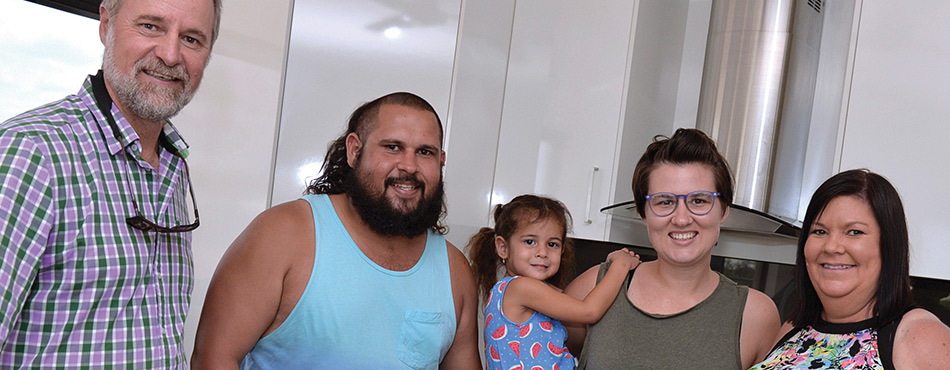
Indigenous Affairs Minister Nigel Scullion with Indigenous Business Australia (IBA) customers Eddie Clarke and Sophie Henry and IBA Home Loan Officer Vanessa McAndrews at their newly built home in Zuccoli, Palmerston. Eddie and Sophie had previously applied unsuccessfully for a home loan with IBA, but were successful after financial advice from IBA’s loan officers.
Buying a home should be a realistic choice for Aboriginal and Torres Strait Islander people and their families. Owning a home can create a source of financial security and independence for current and future generations. The Australian Government provides direct support for Indigenous home ownership. This includes initiatives to increase the number of home owners on remote community-titled land and the progressive resolution of land tenure administration to secure investment and home ownership opportunities.
The Australian Government also provides home loans for Aboriginal and Torres Strait Islander people through Indigenous Business Australia (IBA). As at 30 November 2015, IBA had 4,547 active home loans in major cities, regional and remote areas. Under the Remote Indigenous Home Loan Programme, which commenced in August 2015, IBA offers specialised support for Aboriginal and Torres Strait Islander people to become home owners in remote locations, including on communally-titled Indigenous land. A number of loans have already commenced under this programme.


